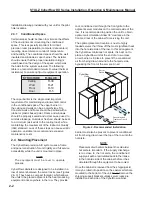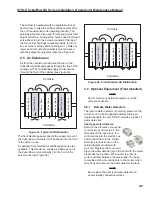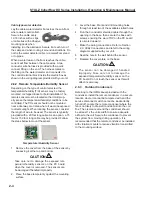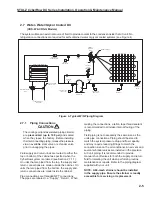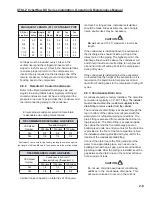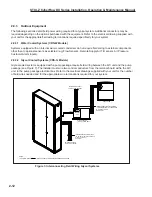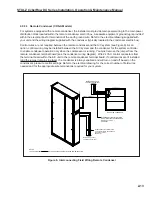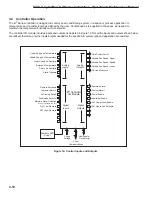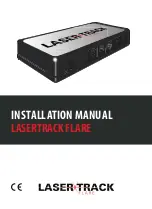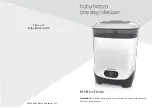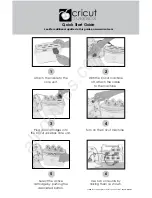
STULZ CyberRow DX Series Installation, Operation & Maintenance Manual
moisture is in the system that still needs to be
boiled off. Proceed to step #5. If the pressure rises
rapidly up to atmospheric pressure (more than 50
microns per minute) it indicates a leak that wasn’t
detected during step #2. In this case troubleshoot
the entire system for leaks and repair them. Then
begin the initial evacuation process again starting
at step #3.
5. If no leaks are detected after the initial vacuum,
release the vacuum and pressurize the system
with 2-3 lbs of dry nitrogen. Allow the system to
stand for two hours with the dry nitrogen charge.
This gives time for the nitrogen molecules to
disperse in the system absorbing moisture.
6. After two hours, release the pressure. Then turn
on the vacuum pump and evacuate the system a
second time down to 1500 microns or less. Close
the vacuum pump isolation valve and pressurize
the system again with dry nitrogen and allow the
system to stand for two hours as in step #5.
7. After two hours release the pressure. Turn on
the vacuum pump and complete the process of
evacuating the system, this time with a goal of
achieving a 250 micron vacuum or less. Close the
vacuum pump isolation valve. When you can hold
the vacuum at 500 microns or lower for at least
2 hours with no signifi cant rise in pressure, the
system is ready to charge.
8. Replace the schrader valve cores if you removed
them during the evacuation steps. You may now
introduce the refrigerant charge through the
schrader valves.
2.10.2.3 Refrigerant Charging Procedures
R410A refrigerant must be weighed in when
performing the charge. Referring to Section 2.9.2.1,
calculate the estimated amount of refrigerant needed
for your system.
When charging a system using a blended refrigerant,
it is essential that the composition of the refrigerant is
maintained. To ensure correct composition, introduce
the refrigerant (R410A) into the system in liquid
form rather than vapor form. Cylinders which are not
provided with dip tubes should be inverted to allow
only liquid
refrigerant to charge the system. Keeping
the temperature of the cylinder below 85°F will help
maintain the correct refrigerant composition while the
cylinder is emptied.
WARNING
If refrigerant gas is released in an enclosed area,
it may accumulate in low areas and near the
fl oor displacing available oxygen. If a major leak
occurs, there is a risk of asphyxiation. In such
case the area should be immediately evacuated
and ventilated. Personnel should remain away
from the area until it is determined to be safe.
INITIAL SYSTEM CHARGE
Follow the step by step instructions below to charge
systems using R410A refrigerant. The initial charge
will be performed by introducing liquid refrigerant to
the discharge side of the compressor or an available
liquid line port with the A/C unit turned Off.
1.
Bleed air from hoses and break the vacuum
by supplying
liquid
refrigerant (R410A) to the
discharge port near the compressor until the
pressure is equalized. This holding charge allows
the low pressure switch to “hold” enabling the
compressor to operate throughout the process of
charging the system.
FINE TUNING THE SYSTEM CHARGE
Once the initial charge is completed, refrigerant will
need to be added with the unit running.
CAUTION
An adequate heat load must be supplied to
ensure a proper charge.
2.
Disconnect the refrigerant cylinder from the
discharge side of the compressor and connect it
to the suction side.
3.
Referring to Section 3.0, start the A/C system
and use the system controller to lower the room
temperature setpoint 3-5°F below actual room
temperature thus ensuring cooling remains on as
the unit is charged.
When fi ne tuning the charge on cool days it may
be necessary to restrict the airfl ow across the
condenser coil to raise the pressure. The fan closest
to the header must be running. When fi ne tuning the
charge, ensure the pressures are correct for the type
of refrigerant used. Refer to the tables in Section
2.10.3 for the operating temperature and pressure
ranges for R410A refrigerant.
2-16
Содержание CyberRow DX CRS-042-G
Страница 94: ......

